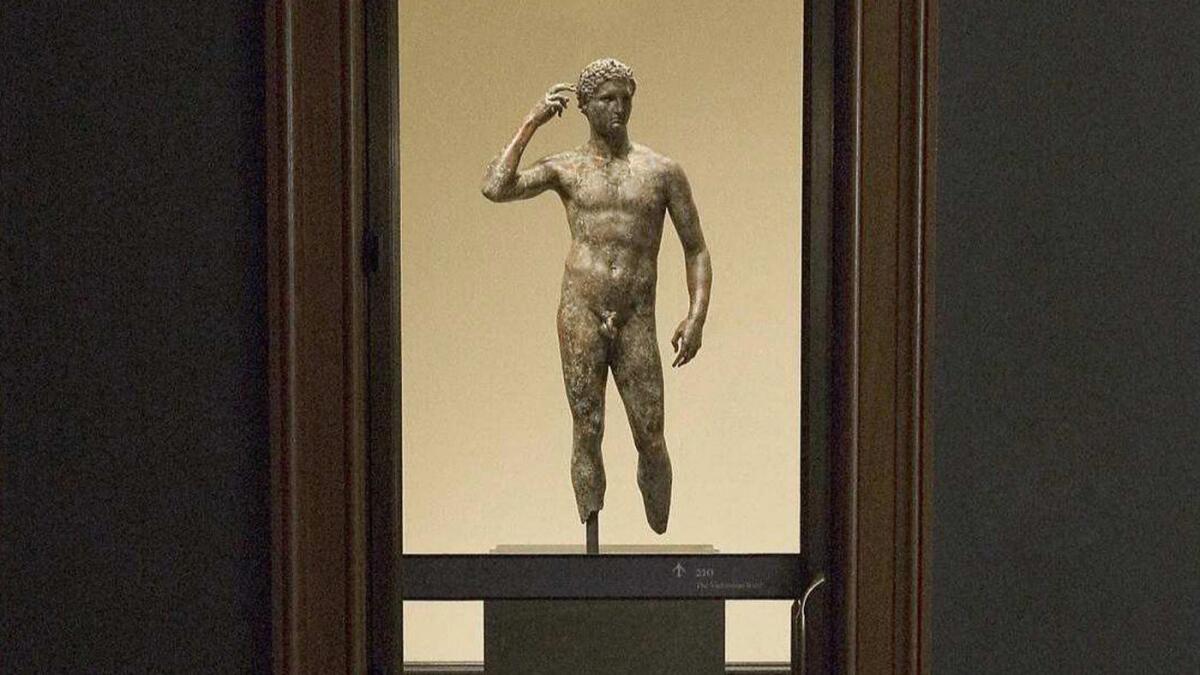Getty loses in Italy’s Supreme Court. What does that really mean for the museum’s prized ‘Victorious Youth’?

Italy’s version of the Supreme Court has ruled that one of the J. Paul Getty Museum’s most prized antiquities — the 2,000-plus-year-old Greek artwork known as “Statue of a Victorious Youth,” or the Getty bronze — should be repatriated back to Italy. The Getty’s response: No.
“We will continue to defend our legal right to the statue,” Lisa Lapin, vice president of communications for the J. Paul Getty Trust, said in a statement about the work, which has been on view at the Getty Villa in Pacific Palisades. “The law and facts in this case do not warrant restitution to the Italian government of a statue that has been on public display in Los Angeles for nearly a half century.”
Court rulings over the statue’s provenance date back to 2007. Italian fishermen found the statue in international waters in 1964, and the Getty bought it from a German art dealer for $3.95 million in 1977, years after Italy’s highest court, the Court of Cassation, concluded in 1968 that “there was no evidence that the statue belonged to Italy,” Lapin said.
The Getty first displayed “Victorious Youth,” which depicts an athlete wearing an olive wreath, in 1978. The work dates to 300 to 100 BC and is believed to possibly have been created by Alexander the Great’s personal sculptor, Lysippus.
In 1989, the Italian government asked the Getty to return the statue, asserting that the artwork been illegally exported by the fishermen. It said that from the moment the art work touched the fishermen’s net, the statue became Italian property — nullifying the legality of the acquisition by the Getty.
The most recent ruling on the statue came on June 8. Judge Giacomo Gasparini of Italy’s Court for the Preliminary Investigations of Pesaro upheld a 2010 forfeiture order issued by another Preliminary Investigations judge. The Getty repeatedly appealed that forfeiture — first in 2010 and again in 2012, leading to additional legal actions. Earlier this year, it again appealed to the Court of Cassation, resulting in this month’s ruling.
So what does all of this mean for the Getty and the future of its treasured artwork?
Not much, the Getty essentially said in a lengthy statement Tuesday.
“The statue is not and has never been part of Italy’s cultural heritage,” Lapin said in the statement. “Accidental discovery by Italian citizens does not make the statue an Italian object. Found outside the territory of any modern state, and immersed in the sea for two millennia, the Bronze has only a fleeting and incidental connection with Italy.
“We believe any forfeiture order is contrary to American and international law. Our priority is to continue our productive and long-standing collaborations with our many Italian colleagues and the Cultural Ministry. It is unfortunate that this issue has been a distraction from that important work.”
When asked if there was any possible scenario (a U.S. court ruling, for example) in which the Getty would agree to yield ownership of the work, or whether the museum would consider a compromise in which it retained official ownership of the statue but shared possession and display of it, the museum said no.
“The Getty legally owns the statue,” the museum said. “We purchased it after the Court of Cassation ruled there was no evidence it belonged to Italy. There still is no evidence.”
The museum said it “will continue to oppose any effort to remove ‘Victorious Youth’ from its home in Los Angeles.”
Follow me on Twitter: @debvankin
More to Read
The biggest entertainment stories
Get our big stories about Hollywood, film, television, music, arts, culture and more right in your inbox as soon as they publish.
You may occasionally receive promotional content from the Los Angeles Times.










